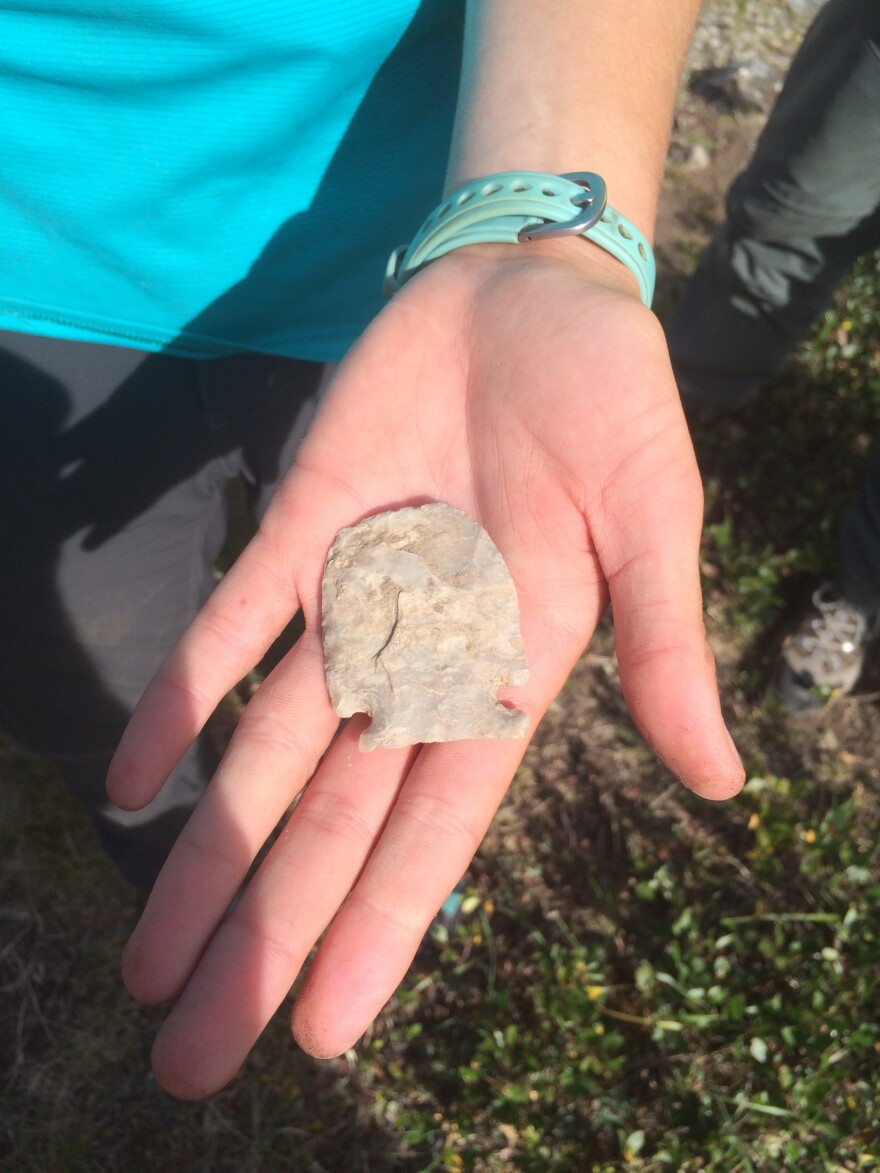It’s late afternoon at the base of Dinwoody Glacier, and its creek is roaring with melted ice nearby. It's been a long day of digging for archeology students Crystal Reynolds, Morgan Robins and Nico Holt.
“We love digging holes!” they say, laughing. “We love playing in the dirt.”
“It's like playing hide and seek with people you never met,” says Holt.
These students are part of a project called the Interdisciplinary Climate Change Expedition or ICCE, sponsored by Central Wyoming College. They point out a faint ring of rocks. It’s here they believe that prehistoric people 11,000 years ago might have camped.

Reynolds takes notes while the others dig and sift.
“We'll break it apart and try to put it through the screen to make sure we don't miss any kind of artifact that might be in here.”
They haven't found much today, but they have good reason to believe there could be artifacts hidden in these clumps of dirt.
“On this site right here, we've got a 9,500 year old spear point and right on the other side of the creek a little bit farther down part of this same site, we've got an 11,500 year old spear point,” says the crew’s leader, CWC archeology professor Todd Guenther.
He says, ancient people would have used such spear heads to hunt mammoths and prehistoric bison. But he says no one knows exactly why these people made the extraordinary effort to visit these glaciers since this canyon would have been too narrow for such giant prey.
“There isn't much to draw people up here in terms of hunting or gathering or foraging,” he says. “And it appears that people were coming up here to see the glaciers. You know, to see where the water comes from. Where does the water spirit originate?”
But Guenther says they may not have lived all that far away. Recently, lodge pads and artifacts were discovered at Burro Flats, about 18 miles overland. There, he says, people would have had everything they needed to survive a winter at 11,000 feet, including tons of white bark pine nuts.
“There's open flowing water coming out of those springs, there's plenty of wood for fire, you stay in your lodge and your wikiup,” he says. “And we think it would have been easy for people to winter up here.”
And, Guenther says, there would have been plenty of meat there too. Last year, his crew found what they believe is the highest bison jump in North America, a cliff they used to run prey off to kill them.

“It's probably 3,000 feet higher than the next highest documented buffalo jump in North America,” Guenther says. “And people say, well, there weren't buffalo up here. But we found a 140-year-old bison horn sheath adjacent to the jump.”
Guenther says, alpine archeology in North America is a very new science. It was only in 2003 that archeologists Rich Adams, Joyce Evans, and Tory Taylor discovered High Rise Village in these same mountains, potentially the oldest high altitude settlement in North America, and that has altered the way researchers thought about human habitation in the American West. Before then, mountains were mostly overlooked by archeologists. He says to prove that people could winter at 11,000 feet, he and his son snowshoed into the area last winter. He said the snow was blown off, exposing plenty of grass.
“And what we saw up there in January was moose, sheep. We saw dead elk because, about two days before we got up there, a pack of wolves had come through and swept through the whole area toward that jump and basically drove the elk just like we hypothesize that prehistoric human hunters drove the bison.”
Guenther says, he's not sure why it’s so hard for others in his field to accept the idea that Native American tribes lived above timberline.
“Now, in Peru, yes. In Scandinavia, yes. In the Alps, yes. All over the world people can winter in the mountains but, not our Indians.”
UW archeology student Nico Holt agrees there’s an unwillingness to rethink those old ideas. Holt is Northern Arapaho and Eastern Shoshone. When it comes to the theory of whether his ancestors could have wintered up here, he says, “That wasn't a revelation at all for us. You know, they called us Sheep Eaters because we lived up here and ate sheep. Well, Grandma's side of the family, at least,” he says of the Shoshone side of his family and laughs.

Archaeologist Todd Guenther says, the idea of prehistoric high altitude settlement is still a revelation for many in his field. But next month, he and some of his students will have a chance to defend their theories on an international stage when they present their findings at a glacial archeology conference in Austria.
And he has plans for future digs that could help clear things up even further.
“You know, there's a whole series of glaciers along the Wind River Range. And so I think if we go up more of these canyons, we'll find more archeology.”
Hiking out of Dinwoody Canyon a few days later, we stop at Burro Flats and imagine the prehistoric village that may have once flourished here. As if to prove the point, about a hundred elk migrate by and stand watching us at the pass. And we’re just a quarter mile away from what may be the highest bison jump in North America.








